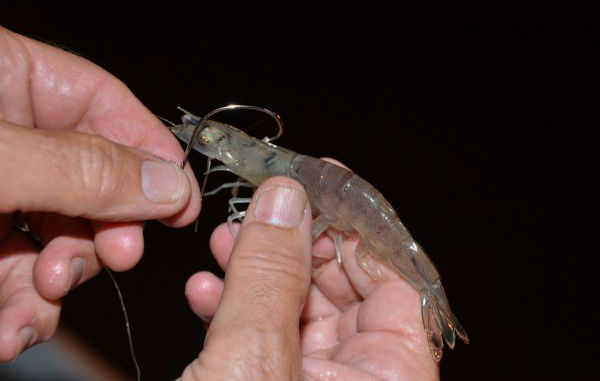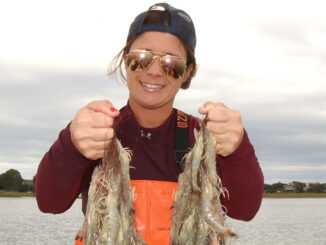
Shrimp make up a large portion of the diets of a myriad of marine life from fish to whales. While some fish are scavengers, speckled trout are sight feeders and prefer to eat their prey alive.
Under some circumstances when speckled trout are in a feeding frenzy, they will eat live shrimp and the pieces of shrimp they encounter, but most of the time, a lively shrimp will bring more bites over a chunk of dead shrimp dangling in the water column.
When using live shrimp for bait, anglers need to hook them in strategic places making sure not to penetrate any vital organs that would kill them instantly.
Guide Kevin “Stump” Grant routinely uses live shrimp in the fall, and he keeps them alive as long as possible on a hook.
“To keep the shrimp alive, I insert the hook under the horn and avoid the black spot,” he said. “The black spot is the brain, and the shrimp will die instantly when you put a hook through it.”
As soon as shrimp die, they begin to fall apart and lose their fish-attracting head and antennas. They will also change from translucent to an opaque color, a tell-tale sign they have expired.
“Trout will still eat a dead shrimp, but a shrimp will work much better when alive and kicking around,” Grant said.
In addition to hooking shrimp under the horn, they can be hooked at the top of the bend in the tail, making every effort to miss the lateral line. While not as natural of a presentation, on smaller shrimp, the tail-hook placement is the only option. On small shrimp, the space under the horn and above the brain is very small and tough to miss.
When alive, the dozen little legs swimming in formation and the occasional kick from the mermaid-like tail emit vibrations through the water column, a perfect attraction to charm a gator speckled trout into gulping away.





Be the first to comment